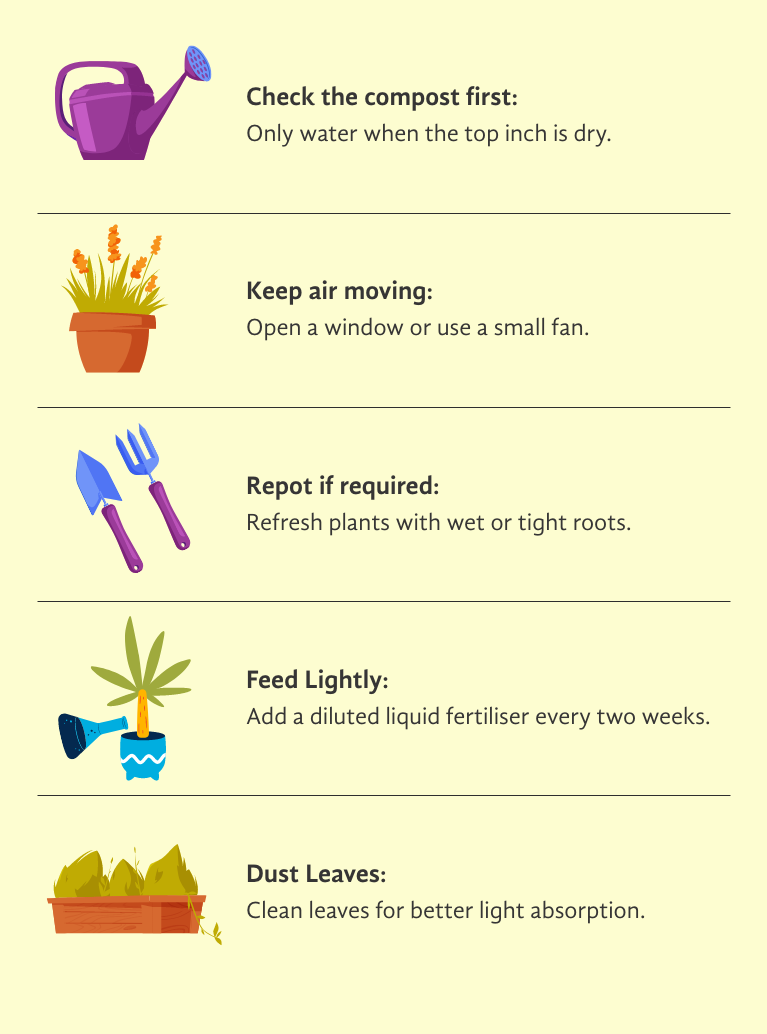Why Is My Peat-Free Houseplant Compost Soggy Even During Summer?
Summer in the UK brings longer days and warmer weather, perfect for houseplants to stretch their leaves and grow. But if you’re using peat-free houseplant compost, you might notice it staying wet longer than expected, leaving your plants looking droopy. July’s humid air can make this worse, but the good news is, with a few smart tweaks, you can keep your indoor plants happy and healthy in an eco-friendly way. Let’s look at why this happens and how to fix it.
The warmer weather (i.e. outside) will have no effect on houseplants (indoors) – unless you’re moving them into the garden for summer.
The air is highly unlikely to be humid in the house; in fact, it’s likely to be drier.
Why Does Peat-Free Compost Get Soggy?
Peat-free houseplant compost, made from materials like coir, bark, or wood fibre, is a sustainable choice for gardeners. Unlike traditional peat mixes, it holds onto water differently, often staying damp longer, especially in summer’s sticky conditions – see above. If you water too frequently, use pots that don’t drain well or have compost that’s packed too tightly; the roots can end up sitting in water. Understanding these causes helps you create the right setup for your plants.
Simple Ways to Keep Compost Moisture Just Right
You can turn soggy compost around with these practical steps:
- Water Less Often: In July’s humidity – see above, your plants don’t need as much water. Push your finger an inch into the compost—if it’s still damp, hold off. A moisture meter, easy to find at garden centres, can help you get it spot-on.
- Improve Drainage: Mix 20% perlite or coarse sand into your peat-free houseplant compost to let water flow through more easily. This keeps the roots from getting waterlogged.
- Choose Better Pots: Opt for terracotta pots with drainage holes. They pull extra moisture away from the compost, unlike plastic pots that retain it.
Troubleshooting at a Glance
If your plants are struggling, this table can help you figure out what’s going on and how to fix it:
| What You Notice | What’s Likely Wrong | What to Do |
|---|---|---|
| Compost stays damp for days | Too much water or humid air | Let the top inch dry out; add a fan to move air |
| Yellow leaves, mushy stems | Too much water causing root rot | Repot with a perlite mix; use pots with plenty of drainage |
| Soil feels hard or clumpy | Compost has settled and compacted | Loosen the top layer; mix in bark chips |
Repotting for a Fresh Start
July is a great time to repot houseplants, giving them room to grow and fixing soggy compost issues. Here’s how to do it with your peat-free houseplant compost:
- Choose a terracotta pot that is slightly larger than the old one.
- Blend your compost with a handful of perlite to boost drainage. Dampen it slightly—it should feel like a wrung-out cloth, not sopping wet.
- Gently ease the plant out of its pot, brushing off old compost. Clip any dark, soft roots to stop the rot from spreading.
- Settle the plant in its new pot, fill with the mix, and water lightly. Wait a week before watering again to let the roots adjust.
- Place it in bright, indirect light, away from harsh sunlight that can dry the soil unevenly.
This method sets your plants up for success in a sustainable compost.
Summer Houseplant Care Checklist

Boosting Humidity Without Overwatering
Plants like monstera or calatheas enjoy humid air, but soggy compost isn’t the way to provide it. Try these ideas instead:
- Pebble Tray: Set your pot on a tray of pebbles with a bit of water, keeping the pot’s base dry. As the water evaporates, it adds moisture to the air.
- Group Your Plants: Place plants close together to create a naturally humid environment similar to their natural habitats.
- Mist in the Morning: Lightly spray leaves early in the day so they dry by night, avoiding fungal problems.
Clearing Up Peat-Free Compost Myths
Some gardeners hesitate about peat-free compost, especially if they are using it for the first time. But let’s set the record straight:
- Peat-free compost isn’t great for houseplants? Not true. With proper care, it works just as well as peat mixes and is more environmentally friendly.
- Do you need to water peat-free compost more? Actually, it often holds water longer, so you can water less, including in summer.
To know more about peat-free composts read this detailed blog post: Going Peat-Free? Here’s all you need to know.
Conclusion
Mastering peat-free houseplant compost in summer is easier than it seems. By watering carefully, improving drainage, and repotting when needed, you’ll give your plants the perfect home to thrive. These sustainable practices not only keep your indoor garden vibrant but also support a greener planet. With a bit of attention, your houseplants will bring life and beauty to your space all year long.










